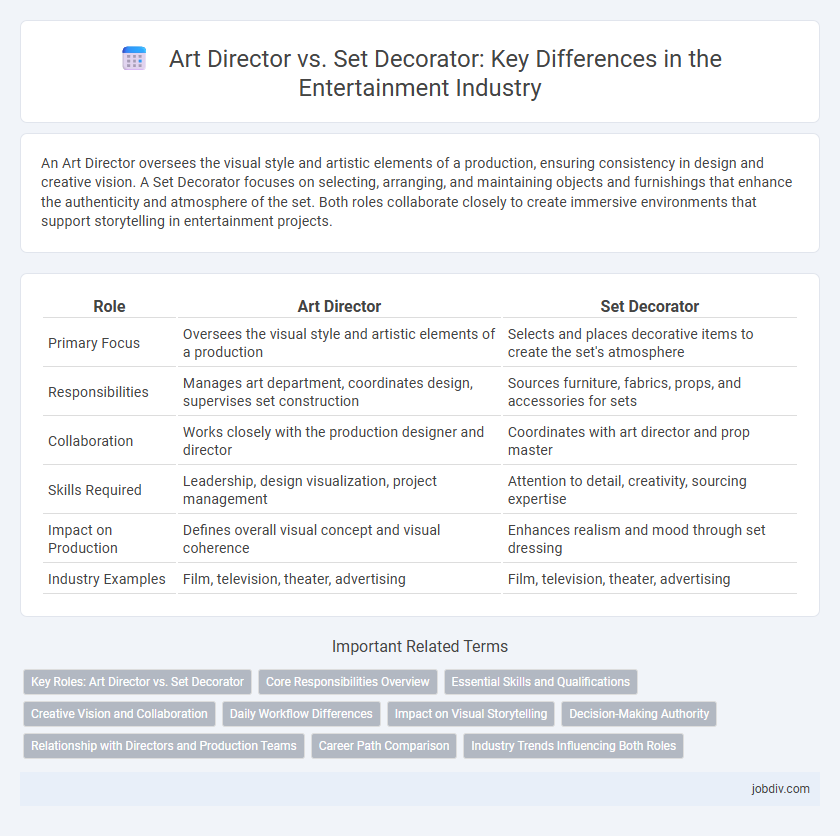An Art Director oversees the visual style and artistic elements of a production, ensuring consistency in design and creative vision. A Set Decorator focuses on selecting, arranging, and maintaining objects and furnishings that enhance the authenticity and atmosphere of the set. Both roles collaborate closely to create immersive environments that support storytelling in entertainment projects.
Table of Comparison
| Role | Art Director | Set Decorator |
|---|---|---|
| Primary Focus | Oversees the visual style and artistic elements of a production | Selects and places decorative items to create the set's atmosphere |
| Responsibilities | Manages art department, coordinates design, supervises set construction | Sources furniture, fabrics, props, and accessories for sets |
| Collaboration | Works closely with the production designer and director | Coordinates with art director and prop master |
| Skills Required | Leadership, design visualization, project management | Attention to detail, creativity, sourcing expertise |
| Impact on Production | Defines overall visual concept and visual coherence | Enhances realism and mood through set dressing |
| Industry Examples | Film, television, theater, advertising | Film, television, theater, advertising |
Key Roles: Art Director vs. Set Decorator
Art Directors oversee the visual style and design concept of a production, managing the artistic team and coordinating with directors and producers to ensure the overall look aligns with the narrative. Set Decorators focus specifically on selecting, designing, and placing all the objects and decor that dress the set, creating an authentic atmosphere and enhancing the story's setting. Both roles collaborate closely, but while Art Directors handle broader design vision and logistics, Set Decorators bring the detailed environment to life through props and furnishings.
Core Responsibilities Overview
Art Directors oversee the visual style and artistic design of a production, coordinating with designers, illustrators, and other creative teams to establish the overall aesthetic. Set Decorators are responsible for sourcing, arranging, and maintaining all decorative elements within a set, including furniture, drapery, and props, ensuring authenticity and consistency with the production's vision. Both roles collaborate closely to create immersive environments that support storytelling in film, television, and theater.
Essential Skills and Qualifications
Art Directors require strong leadership, creative vision, and expertise in graphic design, color theory, and spatial arrangements to oversee visual style and imagery of productions. Set Decorators specialize in detailed knowledge of interior design, props sourcing, period accuracy, and fabric/textile selection to create authentic environments that complement the storyline. Both roles demand collaboration skills, attention to detail, and experience in film, television, or theater production to ensure cohesive and immersive visual storytelling.
Creative Vision and Collaboration
Art Directors focus on shaping the overall creative vision by designing the visual style and coordinating with multiple departments to ensure cohesive aesthetics. Set Decorators specialize in curating and styling the physical environment, selecting furniture, props, and fabrics to bring authenticity and detail to scenes. Collaboration between Art Directors and Set Decorators is essential for blending broad artistic concepts with intricate set elements, enhancing storytelling and viewer immersion.
Daily Workflow Differences
Art Directors manage the overall visual style of a production, coordinating with designers, overseeing set construction, and ensuring the creative vision aligns with the director's goals. Set Decorators focus on selecting and arranging props, furnishings, and decorative elements on set to enhance the environment's authenticity and mood. Daily workflows differ as Art Directors spend more time in meetings and planning sessions, while Set Decorators conduct hands-on sourcing and placement of items on location.
Impact on Visual Storytelling
An Art Director shapes the overall visual concept of a film or production, ensuring consistency in style, color schemes, and design elements that support the narrative tone. A Set Decorator focuses on selecting and arranging objects within the set, adding authenticity and detail that enrich the storytelling environment. Both roles collaborate closely to create immersive visuals that enhance the emotional and thematic impact of the story.
Decision-Making Authority
Art Directors hold significant decision-making authority, overseeing the overall visual style and ensuring consistency across production design elements. Set Decorators focus on selecting and arranging props and furnishings, implementing the Art Director's vision without altering major design decisions. The clear division of responsibilities allows Art Directors to maintain creative control while Set Decorators handle detailed execution within established guidelines.
Relationship with Directors and Production Teams
Art Directors collaborate closely with Directors to shape the visual style and overall aesthetic of a production, ensuring alignment with the director's creative vision. Set Decorators work under the Art Director's guidance to select and arrange furnishings, props, and decor that bring authenticity and detail to each scene. Both roles require seamless communication with production teams to synchronize design elements with filming schedules and technical requirements.
Career Path Comparison
Art Directors typically advance through roles in graphic design or production design, gaining expertise in visual storytelling and team management, while Set Decorators often start as assistants or in props departments, specializing in selecting and arranging decor to enhance narrative authenticity. Both careers demand collaboration with directors and production teams, but Art Directors focus on overarching visual concepts whereas Set Decorators concentrate on detailed environmental elements. Salary ranges vary, with Art Directors generally earning higher median incomes due to broader responsibilities and leadership roles within film and television productions.
Industry Trends Influencing Both Roles
Industry trends such as the rise of immersive experiences and virtual production technology increasingly shape the responsibilities of art directors and set decorators, demanding a blend of creativity and technical expertise. Art directors are now collaborating closely with digital artists to design environments that seamlessly integrate physical and virtual elements, while set decorators emphasize authentic materials and textures to enhance viewer immersion. The growing emphasis on sustainability also influences material choices and design practices within both roles, reflecting an industry-wide shift towards eco-friendly production methods.
Art Director vs Set Decorator Infographic

 jobdiv.com
jobdiv.com